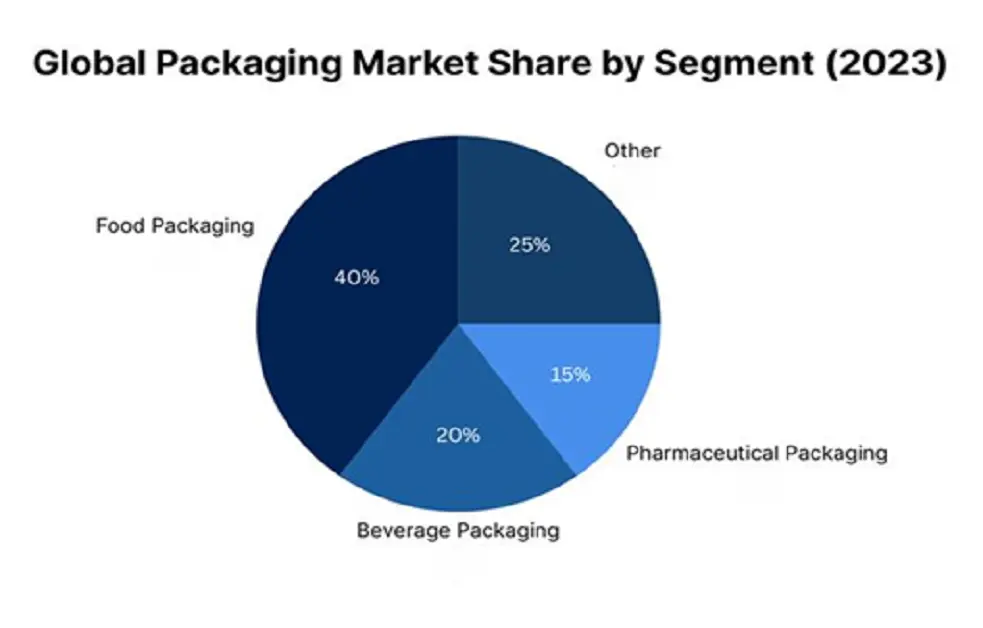Published Date : 16 October 2025
Posted by : Abhishek Bhardwaj
The packaging industry is a cornerstone of the global commerce industry, ensuring products reach consumers safely while improving brand appeal and sustainability. From food and beverages to pharmaceuticals and e-commerce, packaging plays a critical role in product safety, shelf life, and consumer experience. As we move into 2025, the industry is evolving rapidly, fueled by technological advancements, environmental concerns, and changing consumer preferences. This blog highlights the current state of the packaging industry, main trends, innovations, and statistical insights, offering an extensive look at its impact and future.
The Importance of the Packaging Industry
Packaging is more than just a protective layer; it is a vital component of supply chains and marketing strategies. According to a 2024 report by Research Nester, the global packaging market was valued at $1.5 trillion in 2024 and is projected to register a rapid CAGR of 4.5% from 2024 to 2035. This growth is fueled by increasing demand for packaged goods, especially in food, beverages, and personal care products, as well as the boost in e-commerce. Packaging serves multiple purposes as outlined below:
- Protection: Makes sure products remain safe from damage, contamination, or spoilage.
- Convenience: Facilitates easy transport, storage, and usage for consumers.
- Branding: Acts as a marketing tool, representing brand identity and proper product information.
- Sustainability: Deals with ecological issues through eco-friendly materials and designs.
The industry extends to various sectors, including food and beverage, making it the largest segment, followed by pharmaceuticals, cosmetics, and industrial goods. In 2023, food packaging contributed to 40% of the packaging market worldwide, followed by beverages at 20% and pharmaceuticals at 15%. Materials such as plastic, paperboard, metal, and glass lead, with each of them delivering unique advantages and drawbacks. Plastics entailed a 35% share of packaging materials in 2023, followed by paperboard (31%) and metal (15%). In terms of sustainability impact, in 2023, 25% of global packaging was made from recycled materials, to reach 50% by 2030.

Technologies and Trends Reshaping Packaging
1. Sustainability and Eco-Friendly Measures: Increasing environmental concerns are pushing a paradigm shift in the global packaging industry. Consumers and regulators are spreading awareness of reduced waste and eco-friendly solutions. A 2024 report by revealed that 60-70% of global consumers are ready to pay an extra charge for sustainable packaging. This has led to notable innovations in biodegradable, compostable, and recyclable materials.
- Biodegradable Packaging: Materials such as polylactic acid (PLA) and mushroom packaging are gaining popularity. For instance, companies like Ecovative use mycelium, i.e., mushroom roots, to build compostable packaging for electronics and cosmetics.
- Recyclable Materials: The push for a circular economy has increased the use of mono-materials, which are easier to recycle than multi-layered plastics. In 2023, the European Union enforced that all packaging must be recyclable or reusable by 2030, accelerating this trend.
- Reduced Plastic Usage: Brands such as Unilever and Nestle have promised to reduce virgin plastic use by 50% by 2030, choosing paper-based or plant-based alternatives.
2. Smart Packaging and Technology Integration: Smart packaging, combining technologies like QR codes, NFC (Near Field Communication), and sensors, is drastically transforming the industry. According to a Research Nester report in 2024, the smart packaging market is anticipated to reach USD 37.5 billion by 2030, rising at a CAGR of 5.5%.
- Traceability: QR codes and RFID tags help consumers trace a product’s journey from farm to shelf, increasing transparency. For instance, winemakers use NFC tags to guarantee authentic products and provide tasting information.
- Freshness Indicators: Sensors installed in food packaging track temperature, humidity, and spoilage, reducing food waste. In 2023, 1.3 billion tons of food were wasted all around the world, as per FAO data, and smart packaging could help address this issue.
- Interactive Packaging: Companies employ AR solutions to interact with customers. For instance, Coca-Cola’s AR-enabled cans enable consumers to access games or promotions via smartphones.
3. E-Commerce Packaging Boom: The e-commerce sector has redefined packaging demands. Global e-commerce sales touched $5.8 trillion in 2023, according to Research Nester, with projections to jump $8 trillion by 2034. This growth has increased innovations in durable, lightweight, and cost-effective packaging.
- Right-Sizing: Companies such as Amazon implement AI to optimize packaging sizes, reducing material waste and shipping costs. In 2023, Amazon noted a 12% reduction in packaging material owing to such initiatives.
- Protective Packaging: Air pillows, corrugated boxes, and molded pulp are popular for protecting fragile items during the transit process.
- Branded Unboxing Experiences: E-commerce brands invest in custom packaging to enhance customer satisfaction. A 2024 study disclosed that 40% of online shoppers are more likely to repurchase from companies that provide attractive premium packaging.
4. Minimalist and Functional Designs: Consumers favor packaging that is easy to use and visually appealing. Minimalist designs with clean lines and transparent labeling of products are trending, especially in the cosmetics and food sectors.
- Single-Serve Packaging: Portion-controlled packaging for snacks and beverages caters to on-the-go lifestyles.
- Resealable Features: Use of zipper locks and resealable pouches increases product shelf life, mostly used in pet food and snack categories.
- Ergonomic Designs: Packaging with easy-open features or handles improves accessibility, especially for elderly consumers.
Innovations Driving the Future
The packaging industry is adopting groundbreaking technologies and materials to meet modern demands. Given below are a few of the notable innovations:
- Edible Packaging: Made from natural ingredients like seaweed or starch, edible packaging is gaining attention in the food industry. For example, Notpla’s seaweed-based packaging for condiments dissolves in water and is fully biodegradable.
- Nanotechnology: Nano-coatings enhance packaging durability and barrier properties, expanding shelf life without any added weight. A 2024 report by Research Nester predicts the nanotechnology packaging market to grow to $18.2 billion by 2028.
- 3D Printing: Used to create custom packaging prototypes, 3D printing reduces development time and costs. Companies like L’Oreal use nanotechnology to design and innovate bespoke cosmetic containers.
- Green Plastics: Sourced from corn, sugarcane, or algae, these plastics provide a sustainable and eco-friendly option to petroleum-based options. In 2023, Coca-Cola launched a 100% plant-based PET bottle prototype.
The Road Ahead for the Packaging Industry
The packaging industry is on the edge of a revolutionary change. With sustainability taking center stage, businesses are turning to circular economy strategies and renewable resources. Innovations such as AI-powered packaging design and blockchain-backed supply chains are redefining operational efficiency and how brands connect with customers. Thus, balancing affordability, performance, and environmental responsibility will remain a main challenge. Companies that emphasize eco-conscious materials, adopt digital solutions, and customize their packaging for online commerce are likely to get a significant advantage. From the consumer's side, ease of use, clear information, and sustainable choices will continue to guide buying habits and build long-term brand trust.
Contact Us







